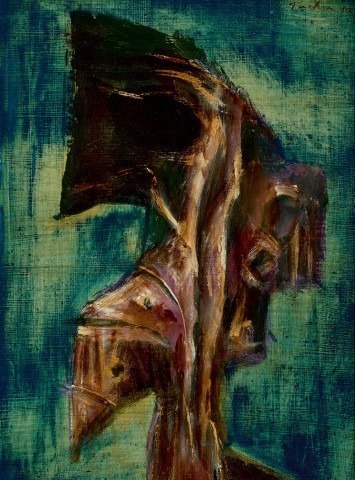ANTIPODEAN HEAD (INTRUDER), 1962
ALBERT TUCKER
oil on composition board
38.0 x 28.0 cm
signed and dated upper right: Tucker 62
bears inscription on gallery label verso: “Antipodean Head (Intruder), 1960”
Australian Galleries, Melbourne (label attached verso, stock no. 26744)
Dr & Mrs Allen C. Kelley, North Carolina, USA
The Mint Museum of Art, North Carolina, USA, a gift from the above, 1983 (label attached verso)
Private collection, Melbourne
Deutscher~Menzies, Melbourne, 21 August 2000, lot 64
The Cbus Collection of Australian Art, Melbourne, acquired from the above
Albert Tucker – Recent Paintings, Australian Galleries, Melbourne, 23 October – 9 November 1962, cat. 8 or 27 (as ‘Head’)
on long term loan to Bendigo Art Gallery, Victoria
Nainby, B., Stanhope, Z., and Furlonger, K., The Cbus Collection of Australian Art, in association with Latrobe Regional Gallery, Melbourne, 2009, pp. 18, 235
After fleeing Melbourne and the upheavals of the Heide circle in 1947, Albert Tucker spent a fruitful thirteen years in Europe, largely in Paris, with periods of extended travel in Germany and Italy. Supported by a modest stipend from John and Sunday Reed and by his then partner, American Mary Dickson, Tucker lived frugally – for a time living and travelling in a tiny homemade caravan – but was, importantly, able to concentrate solely on his art.
Absorbing and working through a range of influences during this period abroad, Tucker made a decisive return to quintessentially Australian subject matter after a joint exhibition with Sidney Nolan in Rome in 1954 demonstrated his friend’s capacity to make an impact on the international stage while ‘remaining an Australian artist in outlook and subject matter’.1 From this time, Tucker undertook his own exploration of the myth of Ned Kelly, the hardship of life in the Australian bush, and the relationship between man and the land. He eventually landed on a powerful new motif – the Antipodean Head – a craggy, scarified, totemic head that dominated the picture plane, and continued to absorb the artist for well over two decades. As he later recalled: ‘Frontier and explorer figures were very real to us, unlike the current generation… and we knew we had an image coming together in the 1940s of an Australian unity, lost since post-war imagination… these works commented on an earlier Australia.’2
Tucker returned home in 1960 on the back of several successes, including having his work exhibited in the Venice Biennale in 1957, winning the Australian Women’s Weekly Prize in 1958, and having paintings acquired by the Museum of Modern Art and The Guggenheim in New York. The occasion of his homecoming at the age of 45 was his first major solo exhibition at Melbourne’s newly established Museum of Modern Art of Australia, which subsequently toured nationally.
Tucker’s Antipodean Head (Intruder), 1962 literally embodies the landscape of which he is part, his face a deeply etched and pitted typography of potholes and crevices. Pictured in profile, as characteristic of the series, the figure’s clenched jaw and darkly shadowed eyes speak of a decidedly masculine determination and grit, where man must fight to both tame and survive the harsh Australian bush. As Tucker explained in an interview with artist James Gleeson in 1979: ‘…I was trying to push myself towards other forms because I was sick of my reliance on the crescent form. I didn’t say it in these terms then, but as I would say from this point of time now, there have to be other sources of energy for your work to discover the forms to gel into. I think the energy is there – scratch it, get it moving, and then it gels into its own form. You are just an attendant, a kind of midwife to it.’3
1. Fry, G., Albert Tucker, The Beagle Press, Sydney, 2005, p. 10
2. Albert Tucker/David Bilcock, 1997, videotaped interview [unreleased] cited ibid., p. 154
3. James Gleeson Interviews: Albert Tucker [transcript], 2 May 1979, James Gleeson Oral History Collection, National Gallery of Australia, https://nga.gov.au/media/dd/documents/tucker.pdf, accessed 29 May 2020
KELLY GELLATLY
